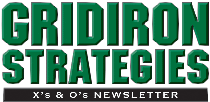- Home
- Subscribe
- Magazine
Current Issue
- Table of Contents
- Feature Article
- Subscribe
- X's & O's Vault
- Gridiron Store
- Help
- Contact Us
Fundamentals of Press-Man Techniques for Cornerbacks
© August, 2011
by Brad Wilson
Defensive Backs Coach • Ashland University
With the increased efficiency of the passing game and the overall ability of the quarterbacks and receivers that we see on a consistent basis, there is a need to have defensive backs that can consistently play tight, or press-man coverage. This allows the defense to disrupt the timing of the opponents passing game, along with taking away holes or windows that will normally be present in zone coverage. Press-man coverage also allows defensive backs to be physical with receivers at the line of scrimmage and forces the receivers to work harder and get them out of their comfort zone right from the snap.
With the initial alignment in press-man coverage, the defense will take away as much of the ball as we can without being in the neutral zone. It is also important to recognize if the receiver is on or off the ball in order to not align in the neutral zone. The defensive back must recognize the initial split of the receiver in order to have an idea of what type of route he will be running as well as what type of release he will take in order to run that route. In most cases, we instruct our cornerbacks to align head up to the receiver (this can be based on split or by game plan). They will have a narrow base with their feet under their hips and weight on the inside balls of their feet. The defensive back should have his butt down with his chest up. His eyes should be low, positioning them between the lower half of the receiver’s numbers and his belt. He should have his hands up and ready to “shoot.”
The defensive back must have a plan at the line of scrimmage, expecting the receiver to make a move in order to get the defensive back to lunge or over-commit his hips one way or the other. Defensive backs must be disciplined with their eyes and feet in order to play efficient press-man coverage. If they are deficient in either one of these areas, they are going to lose more match-ups than they win, minimizing the effectiveness of this coverage. We teach the sequence of “feet, open, hands” to our defensive backs when teaching press-man coverage. The only time that they will use their hands before they open their hips is if the receiver releases straight ahead or stays square and works lateral to the line of scrimmage on the snap. They will then use a two-hand jam on the receiver.
On the snap, the defensive back maintains low eye level, a narrow base, and gets his feet hot. The biggest mistake a defensive back can make at the line of scrimmage is changing his eye level and spreading or not moving his feet. We ask our defensive backs to mirror the receiver’s release and force him to work lateral at the line of scrimmage by running his feet and moving side to side with the stem of the receiver, attempting to keep his body between the receiver and the goal line. By doing this, the DB can keep the receiver within the midpoint (middle of his chest) of his body, allowing him to get two hands inside the receiver’s chest and disrupt the timing of his release. Our defensive back’s goal is to keep the receiver within his midpoint and force him to work lateral for as long as possible before threatening up the field. This will allow the DB to get a physical two-hand jam on the receiver.
The DB will only open his hips and use an “off-hand” jam if the receiver gets outside of his midpoint. Once the receiver gets outside the midpoint of his body, the DB must now drop his inside foot (receiver releases inside) or outside foot (receiver releases outside) and open his hips at a 45-degree angle in the direction of the receiver, maintaining a tight relationship to him. If the defensive back opens his hips too far, he will take himself out of position to get a solid jam on the receiver and ultimately give the receiver a free release. We want our DBs to avoid this, and call this “opening the gate.”
After the DB has opened his hips to the receiver’s release, he will now use his off (backside) hand to jam the receiver. This should be a quick “stab”, rolling his elbow into the receiver with his thumb up and his palm inside. The aiming point is to get the heel of his hand up and underneath the receiver’s breastplate. This will give him more surface area to work with, giving him a more physical jam with the ability to restart the receiver. If the defensive back is lazy with his jam, or doesn’t utilize the quick “stab” technique, he will give the receiver an opportunity to use a counter move of his own along with creating a natural separation between him and the receiver.
Again, the defensive back’s thought process at the line of scrimmage while playing press-man coverage should consist of the following:
• Alignment based on split.
• Proper stance with narrow base, chest up, hands up.
• Mirror receiver’s release by running feet and working lateral.
• Open hips to receiver when he clears the DB’s midpoint.
• Jam receiver with off-hand.
When this sequence of techniques have been executed, the defensive back now has to put himself in position to make a play on the ball vs. any 3-step route. Or, he has to transition his eyes and feet to put himself in a position to maintain his leverage and decrease the separation vs. any intermediate-to-deep developing routes.
Many drills can be incorporated to master your press-man coverage techniques. I try to limit the number of drills and be very clear during meetings and practice as to what we are trying to get out of each drill and how they apply to each step of this coverage. Any and all drills should have a direct correlation to what you have seen, or may see throughout the course of a game.
About the author: Brad Wilson is in his fourth season as Ashland University’s secondary coach. Wilson previously spent two seasons as a student assistant at Ashland (2005-2007) and also coordinated their summer football camps. A 2007 graduate of Ashland, he also coached at the high school level and as a defensive graduate assistant at Bowling Green.
Sign Up for the Play of the Week Newsletter

DEFENSE VIDEOS

MORE X's & O's


|
Home |
Magazine |
Back Issues |
Shopping |
Subscribe |
Contact
Girdiron Strategies PO Box 14041 North Palm Beach, FL 33408 p. 561-355-5068 Copyright 2024, Gridiron Strategies a division of AFM Media, LLC. All Rights Reserved. |

Subscribe
Login
Renew
Change Address
Customer service